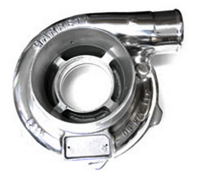 Turbo turbine housings are offered in different sizes to match different requirements of the turbo.
Turbo turbine housings are offered in different sizes to match different requirements of the turbo.
The size of the turbine housing is the inlet cross-sectional Area divided by the Radius from the turbo centerline to the centroid of that area. This is marked as a number followed by A/R. This A/R number will vary depending on the size of the turbo and the intended use.
A lower A/R will forced exhaust gasses through a smaller opening around the turbine wheel. This will casue the wheel to spin faster at lower RPM's, but may physically choke the engine at higher RPM's. A higher A/R number will have a larger area for the gases to pass through the turbine wheel.
This will result in slower spool, but much higher flow and power at high RPM. At our altitude of 5000+ feet, we usually select the smallest A/R available for a particular turbo. This gives us the best spool times and low end torque.
- When matched to a properly sized wastegate, we are able to avoid choking the motor at high RPM's. If absolute horsepower is the goal, we would suggest a larger A/R at the sacrifice of low end grunt.
Other than the A/R size, there are only a few other turbine housing options. Many turbos have the option of an internal or external wastegate.
Subaru Turbo Upgrades | This will entirely depend on the intended use of the turbo for which is better. External wastegate turbo tend to perform better than their internal gated counterparts, but take up considerably more room in the engine bay.
Other options are inlet and out size and flange type. For one size A/R, there might be 3 or 4 different flange options for a turbo.
- All these options can add up to 20 or more different turbine housing options for a single turbo. Make sure you're getting the right options for your intended driving experience.
Being very specific with the type of driving you are going to do pays off in the performance gains. There is a difference between high performance street application and a dedicated racing car turbo setup.



